heating AUDI A3 2011 Owner´s Manual
[x] Cancel search | Manufacturer: AUDI, Model Year: 2011, Model line: A3, Model: AUDI A3 2011Pages: 320, PDF Size: 75.79 MB
Page 15 of 320

[I) Tips
If the ind icator lamp i lluminates wh ile you a re dr iv ing , there is a
ma lfunction in the vehicle damping. Th e chassis shou ld b e insp ected
immediately by an author ized Audi dealer. •
Applies to veh icles : with t ir e p re ssure m onito rin g s yste m
Tire pressure monitoring system - telltale
indicator Lamp ...
The warning/indicator light appears in the event of a
significant loss of air pressure .
The ..Jwarning/indicator light illuminates for a few seconds after the
ignition is turned on as function check and then goes out .
If the symbol appears, pressure is too low in at least one tire.
When the system detects a ma lfunction, the warning/ind icator light
will flash for approximately one minute and then remain continu ously i lluminated. This sequence will continue upon subsequent
vehicle starts up as long as the malfunction exists . Contact your
authorized Audi dea ler and have the ma lfunction corrected .
For more informat ion=>
page 264. •
Electronic power control Dr.
This warning/indicator light monitors the electronic
power control.
The warn ing/ indicator light ( Electronic Power Control) illumi-
nates when you switch on the ignition as a function check.
[ i J Tip s
If this warning/indicator light illuminates while you are driving, then
there is a ma lfunct ion in the engine e lectronics . Have the ma lfunct ion
Controls and equip
ment Safety first
In
strum ents and warning /indicator lights
corrected as soon as possible by your authorized Audi dealer or qual
ified wo rkshop. •
Applies to ve hicles : w it h d ie se l e ng in e
Glow plug system/ Engine malfunction C
The indicator lamp lights up to show that the glow plugs
are preheating. It flashes if there is an engine malfunc tion .
Warn ing light stays lit up
If the -indicator light illuminates, the glow plug system is act ive.
You should start the engine immediately afte r the indicator light
switches off. The ind icator light only illumina tes for approximately 1
second if the engine is warm o r if the outside tempe rature is above 46
QF (8 QC).
There is a fault in the glow plug system if the warning light does
not light up when the engine is
cold . Contact an authori zed Audi
dealer or a qualified workshop .
Warning light fl ashe s
If a malfunct ion develops in the engine management system while
you are driving, the glow plug light will flash
ilf . The engine should
be checked by an autho rized Aud i dealer or a qualified workshop as
soon as possible.
& WARNING
If yo u do not pa y attenti on t o the w arning light s tha t h ave com e
on, thi s co uld lead t o pe rso nal injury o r dama ge to y our veh icle .•
Vehicle care Technical data
Page 86 of 320
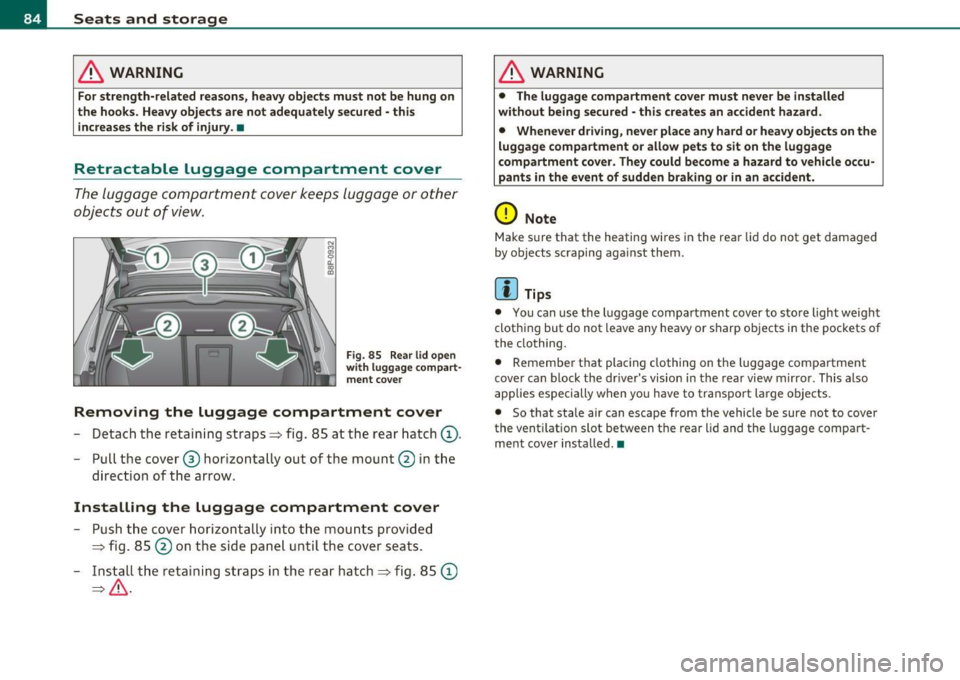
Seats and storage
& WARNING
For strength-related reasons , heavy objects must not be hung on
the hook s. Heavy objects are not adequately secured -thi s
increase s the risk of injury. •
Retractable luggage compartment cover
The luggage compa rtment cover keeps lugga ge or o ther
objects out o f view.
Fig. 85 Rea r lid ope n
w ith luggag e com part
me nt co ver
Removing the luggage compartment cover
- Detach the retaining stra ps => fig. 85 a t the rear hatch (D .
- Pull the cover ® hor izonta lly out of the mount @ in the
d irection of t he arrow.
Installing the luggage compartment cover
- Push t he cover hori zontally into t he m ounts pr ovid ed
=> fig. 85 @ on t he sid e panel u ntil t he cover seats.
- Ins tall t he re ta ining st ra ps in the rea r hatc h=> fig. 85
©
=> & .
& WARNING
• The luggag e compartment cover must never be insta lled
without being secured -this creates an accident hazard.
• Whenever dri ving , neve r place any hard or heavy objects on the
luggage compartment or allow pet s to sit on the luggage
compartment cover . They could become a hazard to vehicle occu
pants in the event of sudden braking or in an accident.
0 Note
M ake s ure that the heating wi res in the rear lid do not get damaged
by objects scrap ing aga inst them.
(I) Tips
• You can use the luggage compa rtment cov er to sto re light we igh t
cloth ing but do not leave any heavy or sharp objects i n the pockets of
the clothing.
• Remembe r th at plac ing clothing on t he luggage compa rtment
cove r can block the dr iver's vision in the rear view m irro r. This also
app lies especially when yo u have to trans po rt large objects.
• So that state air can escape from the vehicle be sure not to cover
the vent ilatio n slot between the rear lid and the luggage compart
m en t cover insta lled .•
Page 97 of 320
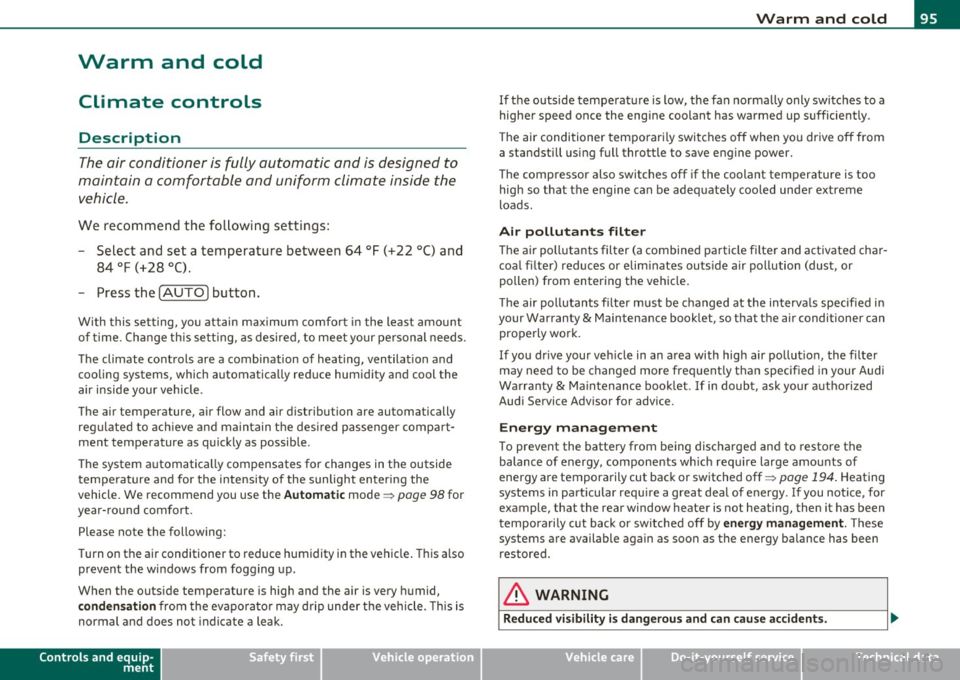
Warm and cold
Climate controls
Description
The air conditioner is fully automatic and is designed to
maintain a comfortable and uniform climate inside the
vehicle .
We recommend the fo llowing sett ings:
- Selec t and se t a tem pera ture between 64
°F (+22 °C) and
84
°F (+28 °().
- Press the [AUTO] but ton .
With this setting, you attain maximum comfort in the least amount
o f ti me. Ch ange th is se tt ing, as desired, to meet your pe rsonal needs.
Th e climate controls are a combination of heating, ventilat ion a nd
coo ling systems, which automatica lly red uce hum idity and cool the
air insi de your vehicle.
T he air temperature, air flow and a ir distribution are automatically
reg ulate d to achi eve and main tain t he desi red passenger compa rt
ment temperature as q uick ly as possible .
Th e system automatica lly compensates for changes in the outside
tempe ra ture and for the intensity of the sunlight enteri ng the
vehicle. We recommend you use the
Automatic mode ~ page 98 for
year- ro und co mfort.
Please note the following:
T urn on the air conditioner to reduce humidity in the vehicle . This also
preven t the wi ndows from fogging up .
When the outs ide temperature is hig h and the air is very humid,
condensation from t he ev apo ra to r m ay d rip under t he veh icle . T his is
normal and does not indicate a leak.
Controls and equip
ment Safety first
Warm and cold
If the outside temp
erature is low , the fan no rma lly only switches to a
highe r speed once the engine coolant has warmed up s ufficient ly .
Th e air condi tioner tempo rari ly swi tches off when yo u drive off from
a standstill using full throttle to save engine power.
Th e comp resso r also switches off if the coolant temperature is too
high so that the engine can be adeq uate ly coo led unde r extreme
loads.
Air pollutants filter
Th e a ir po llutants filter (a combined pa rticle filte r and activated cha r
coa l f il ter) reduces or elim inates outs ide a ir pollution (dus t, or
pollen) from entering the veh icle.
Th e air pollutants fi lter mus t be changed at t he in terv als specified i n
your Warranty
& Maintenance book let, so that the air conditioner can
properly wo rk.
If you dr ive your veh icle in an a rea with high air pollut ion , the fi lter
may need to be changed more frequent ly than specified in your Audi
Wa rranty
& Ma intenance boo klet . If in doubt, ask you r autho rized
Audi Service Advisor for advice.
Energy management
T o prevent the batte ry from being disc harge d an d to restore the
balance of energy, compone nts wh ic h requ ir e large amou nts of
energy are temporarily cut back or sw itched off~
page 194 . Heating
systems in part icular requ ire a g rea t deal of e nergy.
If you notice , for
example, that the rear window heate r is not heating, then it has been
t emporari ly cu t back or sw itched off by
energy management . These
systems are available again as soon as the energy ba lance has been
restore d.
& WARNING
Reduced visibility i s dangerous and can cause accidents.
Vehicle care Technical data
Page 98 of 320
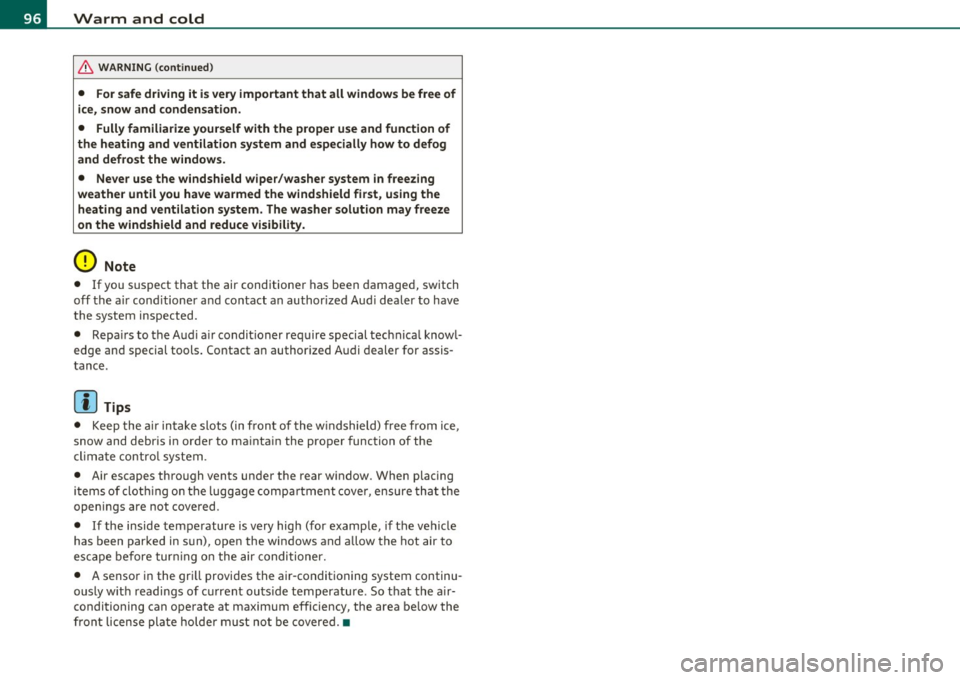
Warm and cold
& WARNING (continued)
• For safe driving it is very important that all windows be free of
ice, snow and condensation.
• Fully familiarize yourself with the proper use and function of
the heating and ventilation system and especially how to defog
and defro st the windows.
• Never use the windshield wiper/washer system in freezing
weather until you have warmed the windshield first , using the
heating and ventilation system . The washer solution may freeze
on the windshield and reduce visibility.
0 Note
• If you suspect that the air conditioner has been damaged, sw itch
off the a ir conditioner and contact an author ized Aud i dea ler to have
the system inspected.
• Repa irs to the Audi a ir conditioner require special technical knowl
edge and special tools . Contact a n author ized A udi dealer for assis
t ance .
rn Tips
• Keep the a ir intake slots (in fron t of t he w indshield) free fr om ice,
snow and debris i n order to ma inta in the proper function of the
cl im at e contr ol syste m.
• Air escapes thro ugh vents unde r the rear w indow. When placing
i t em s of clot hing on t he lugg age compa rtment cover, ensure tha t the
openings are not covered.
• If th e inside tem pe rature is very high (for example, i f the ve hicle
has been parked in s un), open the windows and allow the hot air to
es cape be fore tur ning o n the air conditioner.
• A senso r in the gr ill provides the air -conditioning system continu
ously w it h readings of c urrent ou ts ide temperature . So t hat the a ir
conditioning can ope rate at maximum efficiency, the area be low the
fron t license pla te holde r m us t no t be covere d.•
Page 99 of 320

Controls
This overview will help you to familiarize yourself with the
air conditioning controls.
F ig . 1 01 Air co nditi onin g co ntro ls
Th e d isp lay shows the temperature selected a nd the blowe r setting .
You can set the temperatu re for the driver's side us ing the left rota ry
switch @and the tempe rature for the passenger's s ide with the right
switch @.
Functions are turned on and off by touching the buttons . The diode in
t he b uttons illumina tes when the f unction is active .
The grille between the buttons
G / G and !AUTO I must remain
unobstructed ; there are measurement sensors beh ind it.
• Do not seal off the grille.
• Do not clean the gr ille with a vacuum cleaner, otherwise the
senso rs could be damaged .
Contro ls a nd e quip
m en t Vehicle
OP-eration
Warm and cold
But- Function
ton(s )
@ Switching t he cooling system on/off
!AUTO] Automatic operation
G G B lower speed setting
( in the
center)
Manual recirculation mode
Automatic rec irculat ion mode
Defrost
Air directed to the w indows
Air from the outlets
Air directed to the footwe ll
Rear window defogger
Page
=;, page 97
:> page 98
=;,page 100
=;, page99
=> page 99
=>page 98
=> page 100
=> page 100
=> page 100
=> page 102
The buttons for setting the air f low direction~,~ and~ can also be
pushed in combination .•
A pp lies to ve hicl es: wit h auto matic a ir cond it ioner
Switching the air conditioner on /off [AC]
- P ress the [AC] button to switch the air cond itioner on or
off.
When the air condi tioner is switched on, the indicator light in the
bu tton is l it .
Whe n the air conditioner is swi tched off, the cooling system is
switched off -the heating and ventilation system is regu lated auto
matically. Sw itching off the coo ling syst em (compressor) saves fuel. .,
Vehicle care Do-it-yourselt service iTechnical data
Page 105 of 320
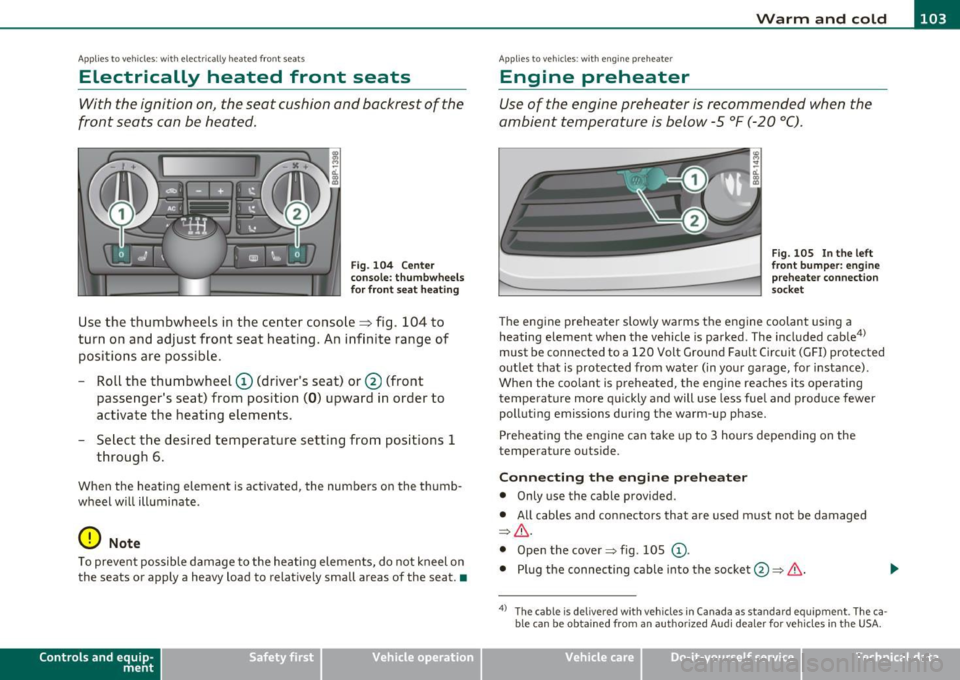
_________________________________________________ W_ a_ r_m _ a_ n_d_ c_ o_ ld _ ___.lfll
Applies to vehicles : wi th electr ically heate d front se ats
Electrically heated front seats
With the ignition on, the seat cushion and backrest of the
front seats can be heated.
Fig. 10 4 Center
console: thumbw heels
f o r fr ont se at heating
Use the thumbwheels in the center console=> fig. 104 to
turn on and adjust front seat heating. An infinite range of
positions are possible .
- Roll the thumbwheel
© (driver's seat) or@ (front
passenger's seat) from position (0 ) upward in order to
activate the heating elements.
- Select the desired temperature setting from positions 1
through 6.
When the heating element is activated, the numbers on the thumb
wheel w ill illuminate .
0 Note
To prevent possible damage to the heating elements, do not kneel on
the seats or apply a heavy load to relatively small areas of the seat. •
Contro ls a nd e quip
m en t Vehicle
OP-eration
App lies to vehicles : with eng ine preheater
Engine preheater
Use of the engine preheater is recommended when the
ambient temperature is below -5 °F (-20 °C) .
Fig. 10 5 I n the le ft
fro nt b umper: engine
prehea ter connection
soc ket
T he engine preheater slow ly warms the engine coolant using a
heating element when the vehicle is parked. The included cable
4>
must be connected to a 120 Volt Ground Fault Circuit (GFI) protected
outlet that is protected from water (in your garage, for instance).
When the coo lant is preheated, the engine reaches its operating
temperature more qu ickly and will use less fuel and produce fewer
polluting emissions during the warm-up phase.
Preheat ing the engine can take up to 3 hours depending on the
temperature outside.
Conn ect ing th e engin e pr ehe ate r
• Only use the cable provided.
• All cables and connectors that are used must not be damaged
=> & .
• Open the cover=> fig. 105
G) .
• Plug the connecting cable into the socket@=>& .
4
) The cable is delivered with veh icles in Canada as standard equipment. The ca
ble can be obtained from an authorized Audi deale r for vehicles in the USA.
Vehicle care Do-it-yourselt service iTechnical data
Page 109 of 320

_________________________________________________ O_ n_ t_ h_ e_ r _o_ a_d _ __.fflll
Starting and stopping the engine
Starting the engine
The engine can only be started with your original Audi
key.
N ... q
i
Vehicles with a gasoline engine:
Fig . 10 8 Ignition key
p osit ion s
- Move the selector lever to the neutra l position (automatic
transmission): selector lev er in P or N) =>
& .
- On vehicles with manual transmission, fully depress the
clutch pedal.
- Turn the ignition key to position@ =>
page 106, fig. 10 7
- do not depress the gas pedal when star ting t he engine!
- Let go of the key as soon as the engine starts .
Vehicles with a diesel engine:
- Set the park ing b rake .
- Move the selector lever to the neutral position (automatic
transmission): selector lever in P or N) =>
& .
Con tro ls a nd e quip
m en t Vehicle
OP-eration
- On vehicles with manual transmission , fu lly depress the
cl utch peda l.
- Turn the ignition key to posi tion
(D => fig . 108. The g low
plug warning light lights up whi le the glow plugs are
warming u p.
- When the warning light goes out, turn the ig nition key to
posi tion @to start the engine @ =>
page 106, fig. 107 .
Do not depress t he gas pedal when starting t he engine!
- Let go o f the key as soon as the engi ne starts.
A cold engine may sound loud after it has been started . Th is is due to
t he hydra ulic valves buil ding up oil p ress ure. This is normal and is not
a need for concern.
If the engine does not start immediately, stop try ing after 10 seconds
and then try to restart the engine about 30 seconds later .
Glow plug system*
Diesel engines are equipped with a glow p lug system whose
preheating t ime is con trolled by the coo la nt and outs ide tempera
t u re . Start the engine
immediately af ter the glow p lug ind icator light
sw itches off .
Th e g low pl ug indica tor light w ill only ill uminate fo r approximately 1
second when the engine is warm or the outs ide temperature is higher
than 46 °F (8 °C). Tha t means yo u ca n sta rt the engi ne
immediately.
To start the diesel engine after the fuel tank has
been run dry
If the fue l tank was run complete ly dry, the start ing process after
refueling with diesel fuel can take longe r than usual -up to one
minute. This is because the fuel system first has to be vented of air
wh ile starting. _,.
Vehicle care Do-it-yourselt service Technical data
Page 192 of 320
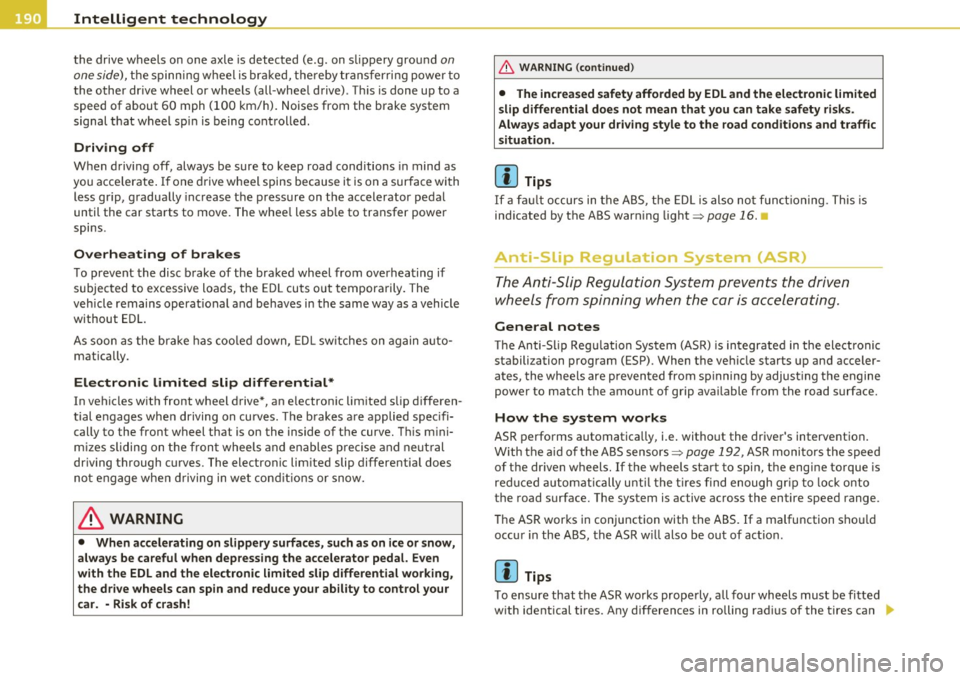
Intelligent technologyL ______________________________________ _
the drive wheels on one axle is detected (e.g . on slippery ground on
one side),
the spinning wheel is braked, thereby transferring power to
the other drive wheel or wheels (all -wheel drive) . This is done up to a
speed of about 60 mph (100 km/h). Noises from the brake system
signal that wheel sp in is being controlled .
Driving off
When driving off, always be sure to keep road conditions in mind as
you accelerate . If one drive wheel spins because it is on a surface with
less grip, gradually increase the pressure on the accelerator pedal
until the car starts to move. The wheel less ab le to transfer power
spms .
Overheating of brakes
To prevent the disc brake of the braked wheel from overheating if
subjected to excessive loads, the EDL cuts out temporarily. The
vehicle remains operat ional and behaves in the same way as a vehicle
without EDL .
As soon as the brake has cooled down, EDL switch es on again auto
matically.
Electronic limited slip differential*
In vehicles w ith front wheel drive*, an electronic lim ited slip differen
tial engages when driving on curves. The brakes are applied spec ifi
cally to the front wheel that is on the inside of the curve. This mini
m izes sliding on the front wheels and enables precise and neutral
driving through curves. The electronic limited slip differential does
not engage when d riving in wet conditions or snow.
& WARNING
• When accelerating on slippery surfaces, such as on ice or snow,
always be careful when depressing the accelerator pedal. Even
with the EDL and the ele ctronic limited slip differential working,
the drive wheels can spin and reduce your ability to control your
ca r. -Risk of crash!
& WARNING (continued)
• The increased safety afforded by EDL and the electronic limited
slip differential does not mean that you can take safety risks .
Always adapt your driving style to the road conditions and traffic
situation.
[I) Tips
If a fau lt occurs in the ABS, the EDL is also not f unct ioni ng. This is
indicated by the ABS warning light=>
page 16.
Anti-Slip Regulation System (ASR)
The Anti-Slip Regulation System prevents the driven
wheels from spinning when the car is accelerating.
General notes
The Anti-Sl ip Regu lation System (ASR) is integrated in the electronic
stabili zation program (ESP) . When the vehicle starts up and acceler
ates, the wheels are prevented from sp inning by adjust ing the engine
power to match the amount of grip available from the road surface.
How the system works
ASR performs automatica lly, i.e. without the driver's intervention.
With the aid of the ABS sensors=>
page 192, ASR monitors the speed
of the driven wheels. If the wheels start to spin, the engine torque is
reduced automatically until the tires find enough grip to lock onto
the road surface. The system is active across the entire speed range.
The ASR works in conjunction with the ABS. If a malfunction shou ld
occur in the ABS, the ASR w ill also be out of action .
[I) Tips
To ensure that the ASR works properly, all four wheels must be fitted
with identical tires. Any differences in rolling radius of the tires can .,
Page 197 of 320

_________________________________________ I_ n_ t_ e_ ll_,igent technology ,__E~-
Battery diagnosis
Battery diagnosis continuously determines the state of the battery.
Sensors determine battery voltage, battery current and battery
temperature. This determines the current state of charge and the
power of the battery .
Idling current management
Idling current management reduces energy consumption while the
vehicle is standing. With the ignition switched off, it controls the
energy supply to the various electrical components. Data from
battery diagnosis is considered.
Depending on the battery's state of charge , individual consumers are
gradually turned off to prevent excessive discharge of the battery and
thus maintain starting capability.
Dynamic energy management
While the vehicle is being driven, dynamic energy management
distributes the energy generated according to the needs of the indi
v idual components. It regulates consumption, so that more electrical
energy is not being used than is being generated and ensures an
optimal state of charge for the battery.
[ i] Tips
• But even energy management cannot negate the limits of physics.
Consider that the power and life of a battery are limited.
• If starting ability is threatened, you are informed by a warning
=> page 196, "Driver notification in the instrument cluster display". •
What you should know
The highest priority is given to maintaining starting capa
bility.
The battery is severely taxed in short-distance driving, in city traffic
and during the cold time of year. Abundant electrical energy is
Controls and equip
ment Safety first Vehicle operation
required, but only a little is generated. It is also critical if the engine
is
not running and electrical components are turned on. In this
instance energy is being consumed but none is being generated .
It is in precisely these situations that you will notice energy manage
ment actively regulating the distribution of energy.
Vehicle stands for an extended period
If you do not drive your vehicle over a period of several days or weeks,
electrical components are gradually cut back or switched off. This
reduces energy consumption and maintains starting capability over a
longer period.
Take into consideration that when you unlock your vehicle, some
convenience functions, such as the remote key or power seat adjust
ment, may not be available. The convenience functions will be avail
able again when you turn on the ignition and start the engine .
With the engine turned off
If you listen to the radio, for example, with the engine turned off, the
battery is being discharged.
If starting capability is jeopardized due to energy consumption, a
message appears in the driver information display.
You have to start the engine to charge the battery.
With the engine running
Although electrical energy is generated when the vehicle is being
driven, the battery can become discharged. This happens mostly
when little energy is being generated and a great deal consumed and
the battery's state of charge is not optimal.
To bring the energy balance back into equilibrium, consumers which
require especially large amounts of energy are temporarily cut back
or switched off. Heating systems in particular require a great deal of
energy . If you notice, for example , that the heated seats* or the
heated rear window are not heating, they have been temporarily cut
back or switched off. These systems will be available again as soon as
the energy balance has been restored. .,
Vehicle care Do-it-yourself service Technical data
Page 223 of 320
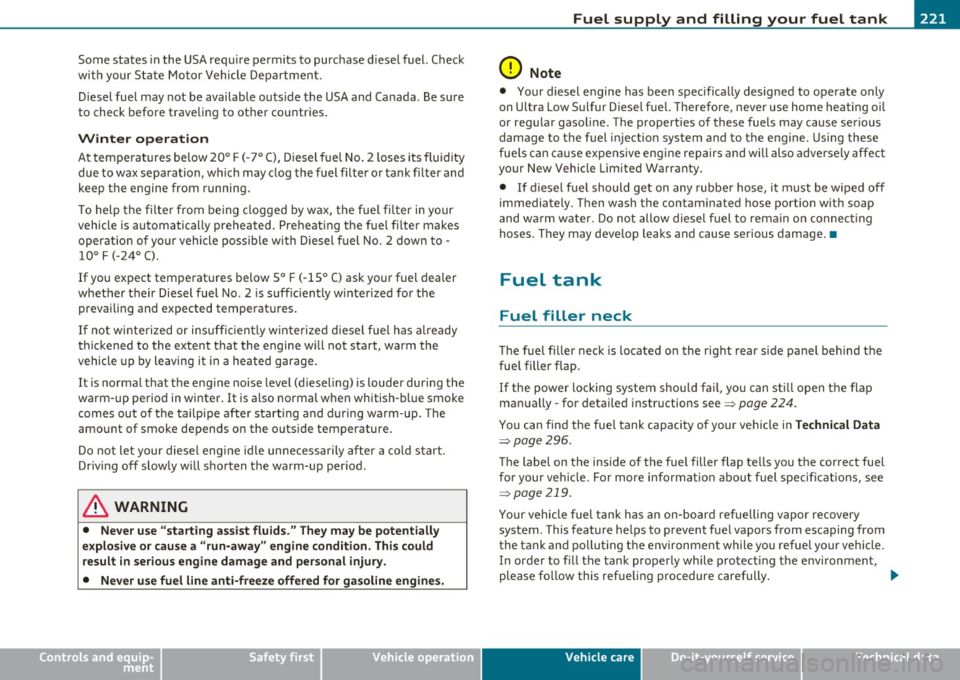
__________________________________ F_ u_ e_l _s _ u...: p....:.. p ___ ly ~ a __ n _ d_ f _i_ l __ li _n _, g~ y __ o_ u _ r_f __ u_ e=.. l ::......:. t.:...a ..:...n :..:.k.::..._ __
Some states in the USA require permits to purchase diesel fuel. Check
with your State Motor Vehicle Department.
Diesel fuel may not be available outs ide the USA and Canada. Be sure
to check before traveling to other countries .
Winter operation
At temperatures below 20° F (- 7° C), Diesel fue l No. 2 loses its fluidity
due to wax separation, which may clog the fuel filter or tank filter and
keep the engine from running.
T o help the filter from being clogged by wax, the fuel fi lter in your
vehicle is automatically preheated. Preheating the fuel filter makes
operat ion of your vehicle possib le with Diesel fuel No. 2 down to -
10° F (-24° C).
If you expect temperatures below 5° F (-15° C) ask your fuel dealer
whether their Diesel fuel No. 2 is suffic iently w interized for the
prevailing and expected temperatures.
If not winte rized or insuffic iently winterized diesel fuel has already
thickened to the extent that the engine will not start, warm the
vehicle up by leaving it in a heated garage.
It is normal that the engine noise level (dieseling) is louder during the
warm-up period in winter.
It is also normal when whitish -blue smoke
comes out of the tailpipe after start ing and during warm-up. The
amount of smoke depends on the outside temperature.
Do not let your diese l engine id le unnecessari ly after a cold start.
Driving off slowly will shorten the warm-up period.
& WARNING
• Never use "starting assist fluids." They may be potentially
explosive or cause a "run-away" engine condition. This could
result in serious engine damage and personal injury.
• Never use fuel line anti-freeze offered for gasoline engines.
Safety first
0 Note
• Your diesel engine has been specifically designed to operate only
on Ultra Low Sulfur Diesel fue l. Therefore, never use home heating oil
or regu lar gaso line. The properties of these fuels may cause serious
damage to the fuel injection system and to the engine. Using these
fue ls can cause expens ive eng ine repairs and will also adversely affect
your New Vehicle Limited Warranty.
• If diesel fuel should get on any rubber hose, it must be wiped off
immediately. Then wash the contaminated hose portion with soap
and warm water. Do not allow diesel fuel to rema in on connecting
hoses. They may deve lop leaks and cause serious damage. •
Fuel tank
Fuel filler neck
The fuel filler neck is located on the right rear side panel behind the
fue l filler flap.
If the power locking system should fa il, you can still open the flap
manually - for detai led instructions see=>
page 224.
You ca n find the fuel tank capacity of your vehicle in Technical Data
=> page 296 .
The label on the inside of the fue l filler flap tells you the correct fuel
for your veh icle. For more information about fuel specifications, see
=> page 219.
Your vehicle fuel tank has an on-board refuelling vapor recovery
system . This feature helps to prevent fuel vapors from escaping from
the tank and polluting the environment while you refuel your vehicle.
In order to fill the tank properly while protect ing the environment,
please follow this refueling procedure carefully. .,,
Vehicle care Technical data